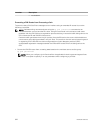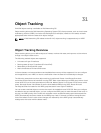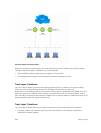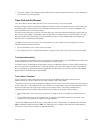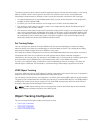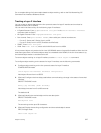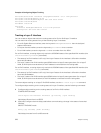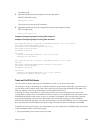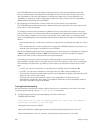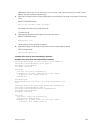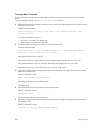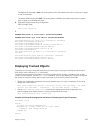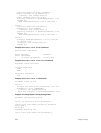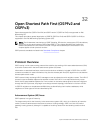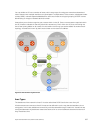The UP/DOWN state of the route is determined by the entry of the next-hop address in the ARP
cache. A tracked route is considered to be reachable if there is an ARP cache entry for the route's
next-hop address. If the next-hop address in the ARP cache ages out for a route tracked for its
reachability, an attempt is made to regenerate the ARP cache entry to see if the next-hop address
appears before considering the route DOWN.
• By comparing the threshold for a route’s metric with current entries in the route table.
The UP/DOWN state of the tracked route is determined by the threshold for the current value of the
route metric in the routing table.
To provide a common tracking interface for different clients, route metrics are scaled in the range
from 0 to 255, where 0 is connected and 255 is inaccessible. The scaled metric value communicated
to a client always considers a lower value to have priority over a higher value. The resulting scaled
value is compared against the configured threshold values to determine the state of a tracked route as
follows:
– If the scaled metric for a route entry is less than or equal to the UP threshold, the state of a route is
UP.
– If the scaled metric for a route is greater than or equal to the DOWN threshold or the route is not
entered in the routing table, the state of a route is DOWN.
The UP and DOWN thresholds are user-configurable for each tracked route. The default UP threshold
is 254; the default DOWN threshold is 255. The notification of a change in the state of a tracked
object is sent when a metric value crosses a configured threshold.
The tracking process uses a protocol-specific resolution value to convert the actual metric in the
routing table to a scaled metric in the range from 0 to 255. The resolution value is user-configurable
and calculates the scaled metric by dividing a route’s cost by the resolution value set for the route
type:
– For ISIS, you can set the resolution in the range from 1 to 1000, where the default is 10.
– For OSPF, you can set the resolution in the range from 1 to 1592, where the default is 1.
– The resolution value used to map static routes is not configurable. By default, Dell Networking OS
assigns a metric of 0 to static routes.
– The resolution value used to map RIP routes is not configurable. The RIP hop-count is
automatically multiplied by 16 to scale it. For example, a RIP metric of 16 (unreachable) scales to
256, which considers a route to be DOWN.
Tracking Route Reachability
Use the following commands to configure object tracking on the reachability of an IPv4 or IPv6 route.
To remove object tracking, use the no track object-id command.
1. Configure object tracking on the reachability of an IPv4 or IPv6 route.
CONFIGURATION mode
track object-id {ip route ip-address/prefix-len | ipv6 route ipv6-address/
prefix-len} reachability [vrf vrf-name]
Valid object IDs are from 1 to 65535.
Enter an IPv4 address in dotted decimal format; valid IPv4 prefix lengths are from / 0 to /32.
Enter an IPv6 address in X:X:X:X::X format; valid IPv6 prefix lengths are from / 0 to /128.
630
Object Tracking



